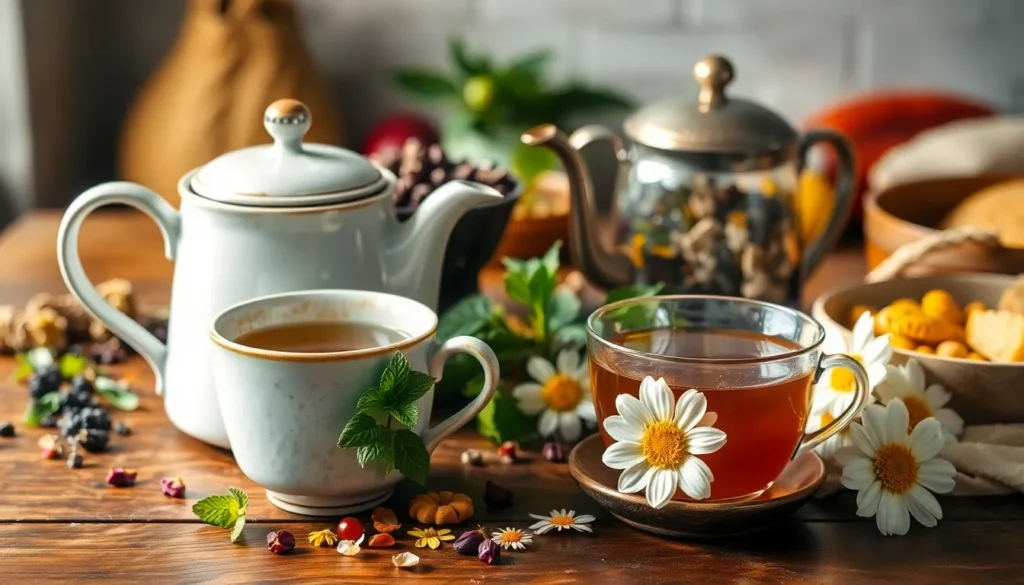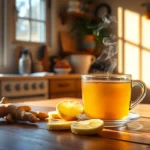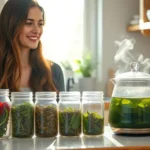Nothing beats the soothing warmth of a perfectly brewed herbal tea – especially when you’ve crafted it yourself from nature’s finest ingredients. We’ve discovered that homemade herbal teas aren’t just incredibly satisfying to make; they’re also packed with wellness benefits that store-bought versions simply can’t match.
From stress-busting chamomile blends to energizing mint combinations, herbal teas offer endless possibilities for customization. We love experimenting with different herb combinations because each cup becomes a personalized wellness ritual that fits our mood and needs perfectly.
Whether you’re battling winter blues or seeking better sleep, our collection of herbal tea recipes transforms simple dried herbs into powerful wellness elixirs. We’ll show you how to create blends that taste amazing while supporting your health goals – no fancy equipment required, just fresh ingredients and a little creativity.
What Are Herbal Teas
Herbal teas are caffeine-free beverages made by infusing dried or fresh herbs, flowers, fruits, and spices in hot water. Unlike traditional teas that come from the Camellia sinensis plant, herbal teas derive their flavors and therapeutic properties from a diverse array of botanical ingredients.
We define herbal teas as tisanes, which distinguishes them from true teas containing caffeine. These aromatic blends harness the natural compounds found in plants to deliver both flavor and wellness benefits. Each herb contributes unique properties, from the calming effects of lavender to the digestive support of ginger.
Our herbal tea collection encompasses single-ingredient brews and complex blends that combine multiple botanicals. Single-ingredient teas like pure chamomile showcase the distinct characteristics of one plant, while blended varieties create harmonious flavor profiles that address multiple wellness needs simultaneously.
The preparation process involves steeping plant materials in water heated to exact temperatures, typically between 200-212°F. Steeping times vary depending on the herbs used, ranging from 3 minutes for delicate flowers to 10 minutes for robust roots and bark. This gentle extraction method preserves the volatile oils and water-soluble compounds that give herbal teas their therapeutic value.
We categorize herbal teas by their primary botanical ingredients and intended effects. Relaxing blends often feature chamomile, passionflower, or lemon balm, while energizing varieties might include peppermint, ginseng, or citrus peels. Digestive teas commonly incorporate fennel, ginger, or dandelion root to support stomach comfort and healthy digestion.
The versatility of herbal teas allows us to create personalized blends that match our individual taste preferences and wellness goals. We can adjust ingredient ratios, combine complementary herbs, and experiment with seasonal variations to develop signature blends that become staples in our daily routines.
Health Benefits of Herbal Teas
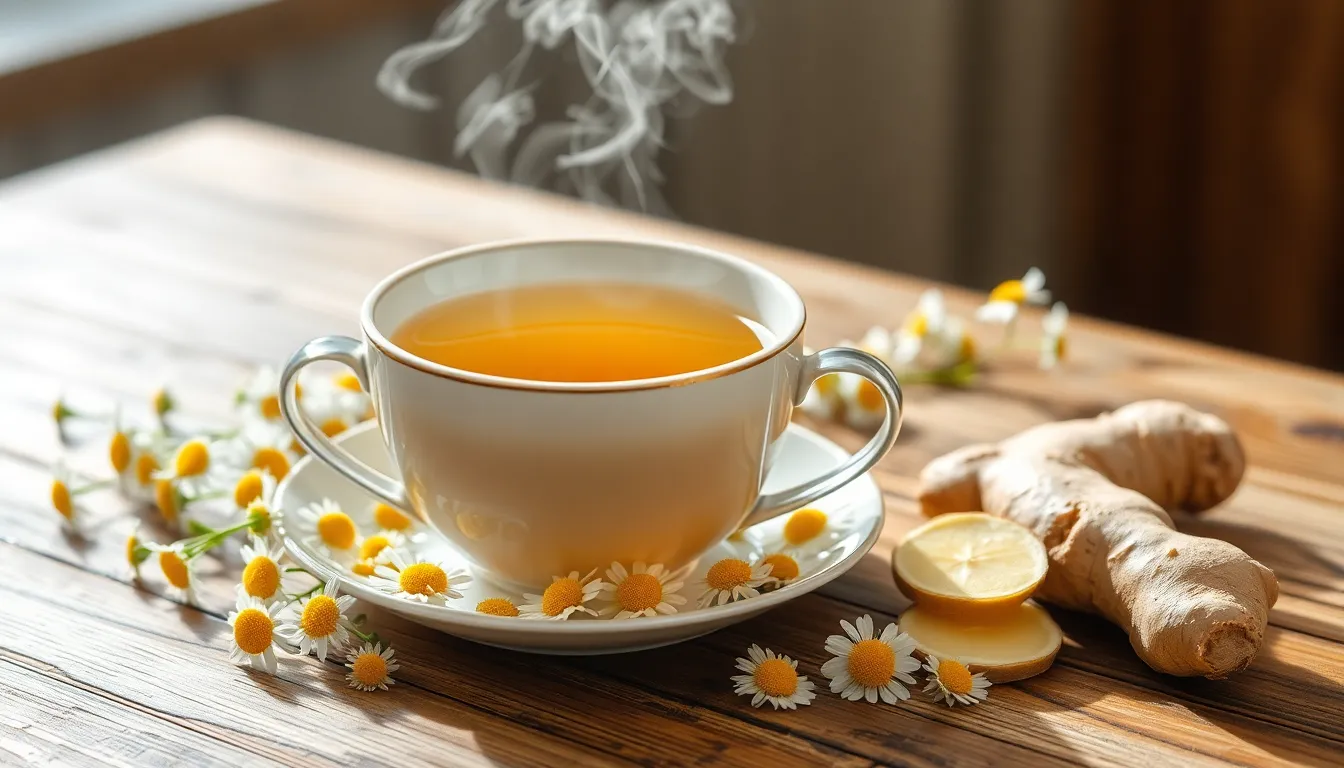
Understanding the therapeutic properties of herbal teas helps us appreciate why these natural beverages have been treasured for centuries. Research demonstrates that herbal teas offer powerful health benefits through their rich content of bioactive compounds including polyphenols and antioxidants that work systematically to support our overall wellness.
Antioxidant Protection
Herbal teas serve as potent sources of antioxidants that neutralize harmful free radicals in our bodies. These compounds work tirelessly to reduce oxidative stress and potentially lower our risk of developing chronic diseases. We benefit from this cellular protection every time we sip our favorite herbal blend.
Anti-Inflammatory Support
Inflammation lies at the root of many health conditions including cardiovascular disease and metabolic disorders. Compounds found in teas such as ginger and chamomile help modulate inflammatory responses in our bodies. This natural anti-inflammatory action supports our immune system and promotes overall health maintenance.
Cardiovascular Health Enhancement
Clinical trials have shown that certain herbal teas offer important cardiovascular benefits. Hibiscus tea stands out for its ability to lower blood pressure in pre-hypertensive individuals through its antioxidant and anti-inflammatory properties. We can incorporate this vibrant red tea into our daily routine to support heart health naturally.
Digestive System Support
Our digestive health receives tremendous support from exact herbal teas that enhance gastrointestinal function. Peppermint tea soothes digestive discomfort while ginger tea promotes healthy digestion and relieves nausea. These teas work by supporting our body’s natural digestive processes and reducing gastrointestinal irritation.
Sleep Quality Improvement
Chamomile tea has earned recognition as a natural sleep aid due to its mild apple scent and calming effects. Studies show that regular consumption can improve sleep quality and reduce nighttime awakenings. We can rely on this gentle herb to help us wind down naturally at the end of each day.
Immune System Strengthening
Ginger tea provides powerful immune boosting properties through its active compound gingerol. This potent antioxidant supports our body’s natural defense mechanisms while also offering pain relief and metabolic syndrome management benefits. Regular consumption helps maintain our immune system’s optimal function.
| Herbal Tea Type | Primary Health Benefits | Key Active Compounds |
|---|---|---|
| Chamomile | Sleep improvement, anti-inflammatory, blood sugar management | Apigenin, chamazulene |
| Ginger | Immune support, nausea relief, pain management | Gingerol, shogaol |
| Hibiscus | Blood pressure reduction, antioxidant protection | Anthocyanins, flavonoids |
| Peppermint | Digestive support, respiratory function, headache relief | Menthol, menthone |
Metabolic Health Benefits
Several herbal teas contribute to metabolic health through various mechanisms. Chamomile tea may help manage blood sugar levels and alleviate PMS symptoms. Ginger tea supports metabolic syndrome management while providing anti-inflammatory benefits. These natural remedies work gently yet effectively to support our metabolic processes.
Respiratory and Pain Relief
Peppermint tea offers dual benefits for respiratory function and pain management. Its antimicrobial effects combined with its ability to improve breathing make it valuable for respiratory health. We can turn to peppermint tea when seeking natural relief from headaches or respiratory discomfort.
Essential Equipment for Making Herbal Tea
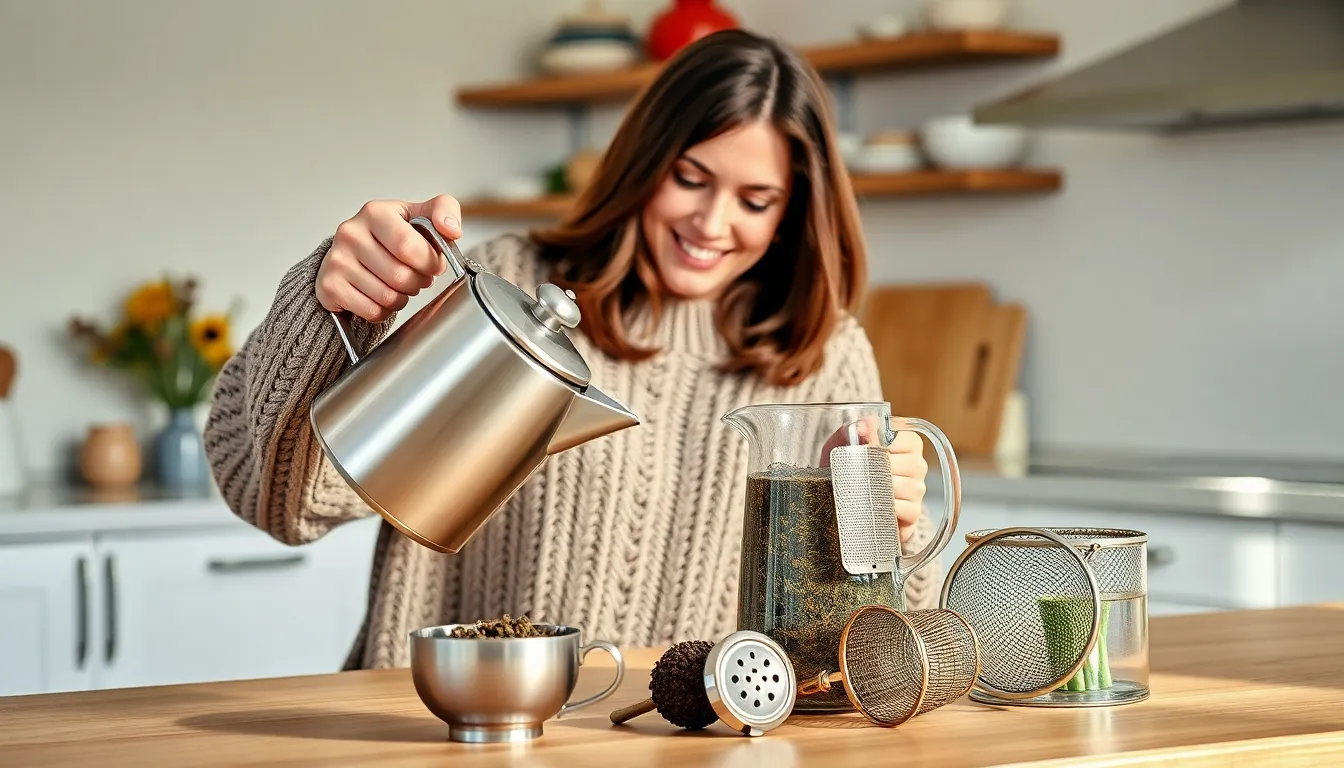
Creating flavorful herbal teas at home requires minimal equipment that most of us already have in our kitchens. We find that having the right tools makes the brewing process smoother and ensures better flavor extraction from our herbs.
Water Heating Essentials
We recommend using an electric or stovetop kettle as our primary water heating device for optimal efficiency. These kettles allow us to heat water quickly and maintain consistent temperatures. Any pot or microwave safe vessel works perfectly when a kettle isn’t available.
Brewing Containers
Our brewing setup can be as simple as using a favorite mug or cup for single servings. Teapots offer excellent options when we’re preparing multiple cups or want to enhance the brewing experience. We find that using familiar containers makes the tea preparation ritual more enjoyable.
Infusion Tools
Loose leaf herbal teas require proper infusion tools to contain herbs during steeping. Tea infusers serve as our primary choice for easy herb containment and removal after brewing. Steeping baskets provide excellent alternatives with their larger capacity for herbs to expand fully.
Fine mesh strainers work effectively for straining herbs from our finished tea. Disposable tea filters offer convenient answers when we need quick cleanup or are brewing on the go.
Optional Accessories
Tea scoops help us measure herbs accurately for consistent flavor profiles. Tongs make removing hot infusers safer and more convenient during the brewing process. While these tools aren’t strictly necessary we find they enhance our tea making experience.
| Equipment Type | Essential Level | Primary Function |
|---|---|---|
| Water heating device | Essential | Heat water efficiently |
| Brewing container | Essential | Hold tea during steeping |
| Infuser/strainer | Essential | Contain loose herbs |
| Tea scoop | Optional | Measure herbs accurately |
| Tongs | Optional | Remove hot infusers safely |
Advanced brewing setups can include temperature controlled kettles for precise water heating. Commercial tea brewers ensure consistency for larger quantities. Automated infusion machines provide convenience for frequent tea drinkers who want perfect results every time.
Basic Herbal Tea Brewing Instructions
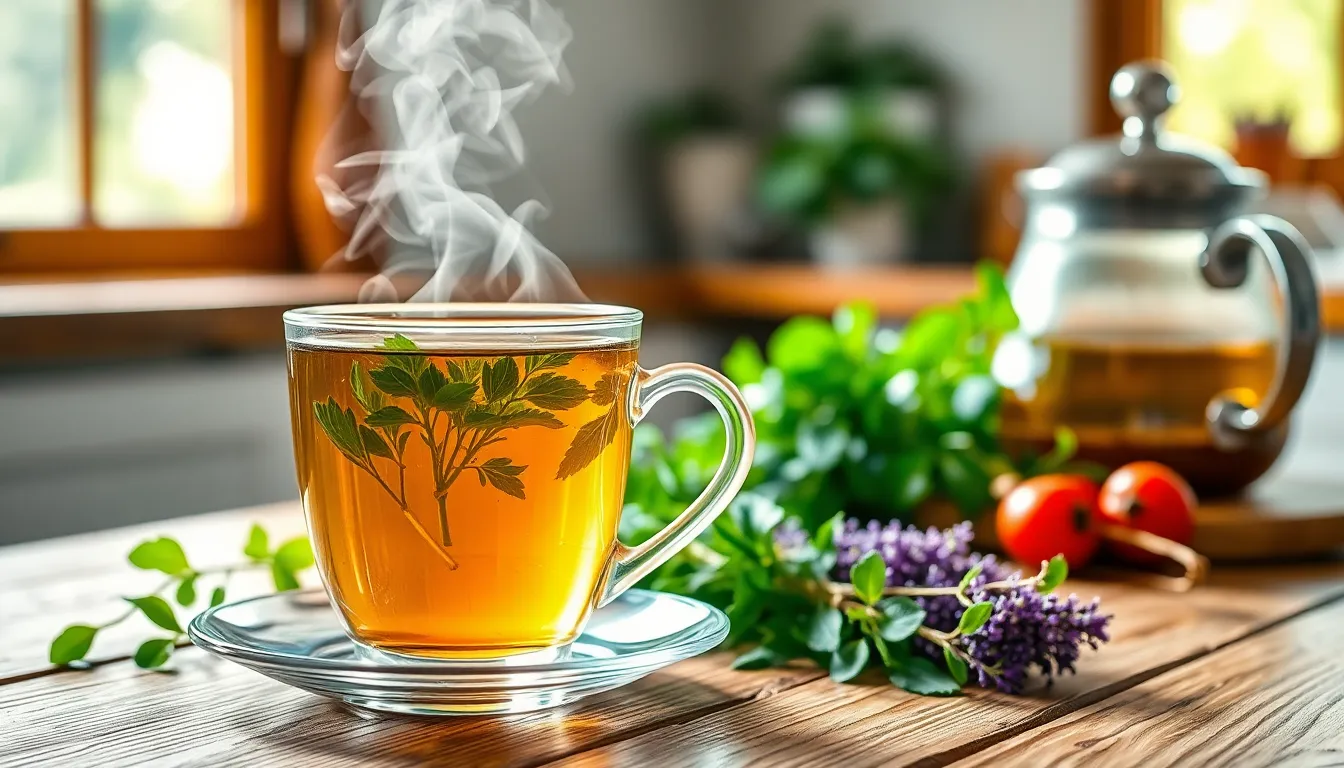
Perfect herbal tea begins with mastering the fundamental brewing techniques that extract optimal flavor and beneficial compounds from your chosen herbs. We’ll guide you through the essential elements that transform simple herbs into therapeutic beverages.
Water Temperature Guidelines
Boiling water at 212°F (100°C) provides the ideal temperature for brewing most herbal teas. Unlike delicate green or white teas that require cooler water, herbal teas benefit from the full heat that effectively extracts oils, flavors, and therapeutic compounds from dried plant materials.
We recommend bringing fresh filtered water to a rolling boil before pouring it over your herbs. This temperature ensures maximum extraction while preserving the integrity of beneficial compounds found in flowers, leaves, roots, and berries.
Steeping Time Recommendations
Herbal teas require longer steeping times than traditional teas to fully release their flavors and therapeutic properties. We suggest steeping most herbal blends for 5 to 10 minutes depending on your desired strength and the exact herbs you’re using.
Delicate flowers like chamomile perform well with shorter steeping times around 5 minutes, while tougher materials such as roots and bark may benefit from the full 10-minute extraction. Some herbs may require exact timing, so we always recommend checking package instructions for optimal results.
For an even stronger flavor profile, you can simmer herbs gently in a covered saucepan for 10 to 12 minutes instead of traditional steeping methods.
Tea-to-Water Ratios
Proper herb-to-water ratios ensure balanced flavor without waste or weakness in your final brew. We recommend using 1 heaping teaspoon of loose leaf herbs per 6 ounces of water as your starting point.
| Measurement Method | Herb Amount | Water Amount |
|---|---|---|
| Standard Ratio | 1 heaping teaspoon | 6 ounces |
| Bulk Brewing | 5 grams | 16 ounces |
Another effective approach involves using 5 grams of loose leaf herbs for 16 ounces of water when brewing larger quantities. Both fresh and dried herbs work beautifully in these ratios, though dried herbs typically require longer steeping times to achieve the same intensity as their fresh counterparts.
Calming Herbal Tea Recipes
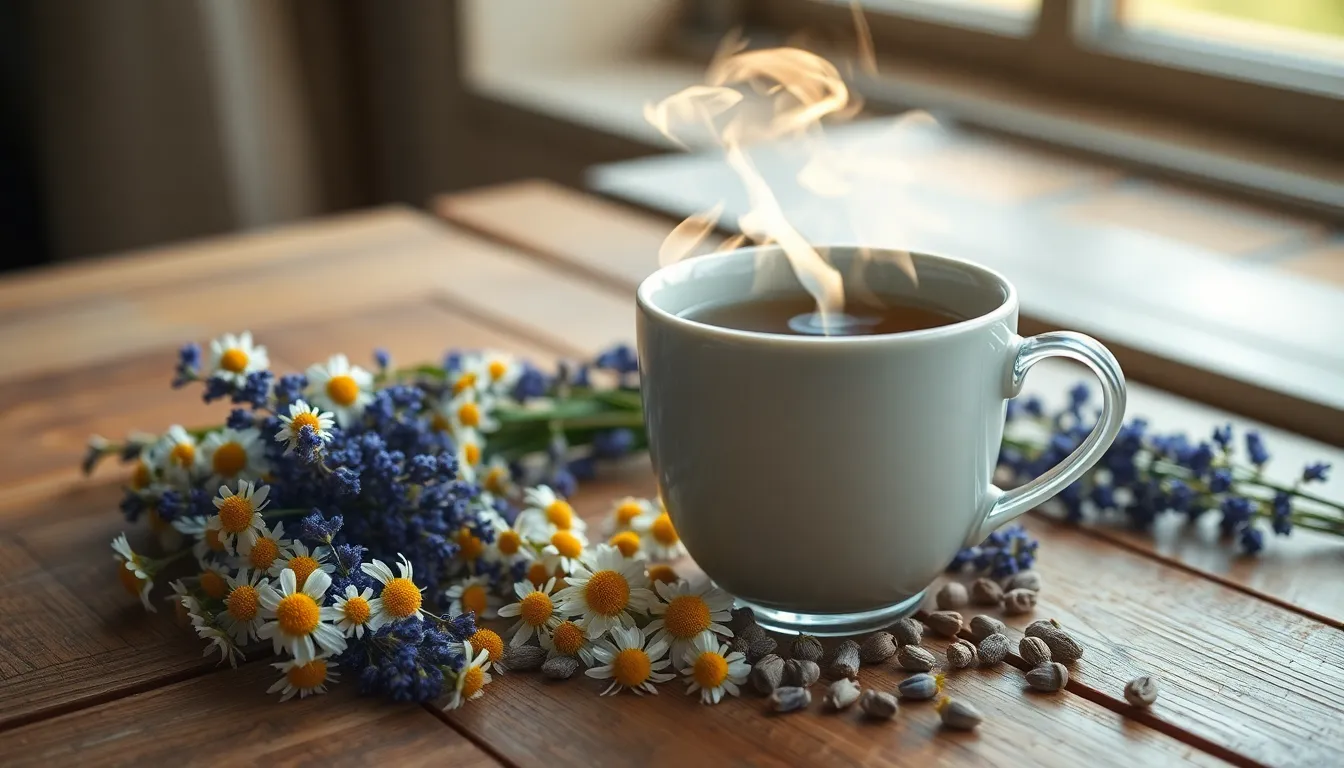
These gentle herbal blends harness nature’s most soothing botanicals to create deeply relaxing teas that ease stress and promote tranquility. Each recipe combines complementary herbs known for their calming properties and therapeutic benefits.
Chamomile Lavender Tea
The marriage of chamomile and lavender creates one of the most effective stress-relieving herbal teas available. Both herbs work synergistically on the nervous system with chamomile containing chamazulene compounds that reduce inflammation while lavender provides antiseptic and anti-inflammatory qualities that support overall healing.
Ingredients:
- 1 tablespoon dried chamomile flowers
- 1 teaspoon dried lavender buds
- 2 cups boiling water (212°F)
- Honey to taste (optional)
Instructions:
- Combine chamomile and lavender in your tea infuser or teapot
- Pour boiling water over the herbs
- Steep for 7-10 minutes to extract maximum therapeutic compounds
- Strain and sweeten with honey if desired
- Serve warm for best calming effects
This floral blend offers multiple wellness benefits beyond relaxation. The tea aids digestion by calming enteric nerves and reducing bloating and gas. Regular consumption supports heart health by lowering bad cholesterol levels while providing powerful antioxidant protection against cellular damage.
Lemon Balm Mint Tea
Lemon balm and mint create a refreshing yet calming combination that addresses both stress and digestive concerns. Lemon balm reduces anxiety naturally while mint soothes stomach discomfort and promotes healthy digestion.
Ingredients:
- 2 tablespoons fresh lemon balm leaves (or 1 tablespoon dried)
- 1 tablespoon fresh mint leaves (or 1 teaspoon dried)
- 2 cups boiling water
- Fresh lemon slice (optional)
Instructions:
- Gently bruise fresh herbs with the back of a spoon to release oils
- Place herbs in your brewing vessel
- Pour boiling water over the leaves
- Cover and steep for 5-7 minutes
- Strain thoroughly and add lemon slice if desired
- Enjoy warm or chilled over ice
This mild calming tea works particularly well for evening consumption when you need gentle relaxation without heavy sedation. The combination alleviates stress while supporting comfortable digestion after meals.
Passionflower Tea Blend
Passionflower tea offers profound anxiety relief and sleep improvement through its unique ability to increase gamma-aminobutyric acid (GABA) levels in the brain. This compound reduces brain activity naturally and promotes deep calmness and restful sleep.
Ingredients:
- 1 tablespoon dried passionflower
- 1 teaspoon dried chamomile (optional enhancement)
- 1/2 teaspoon dried lemon balm (optional)
- 2 cups boiling water
Instructions:
- Measure passionflower and any additional herbs into your infuser
- Pour freshly boiled water over the herb blend
- Steep covered for 10-15 minutes for maximum potency
- Strain carefully as passionflower can be quite fine
- Drink 30-60 minutes before desired sleep time
We recommend starting with smaller amounts of passionflower to assess your individual tolerance. This powerful herb works best when consumed consistently as part of an evening routine for anxiety management and improved sleep quality.
Energizing Herbal Tea Recipes
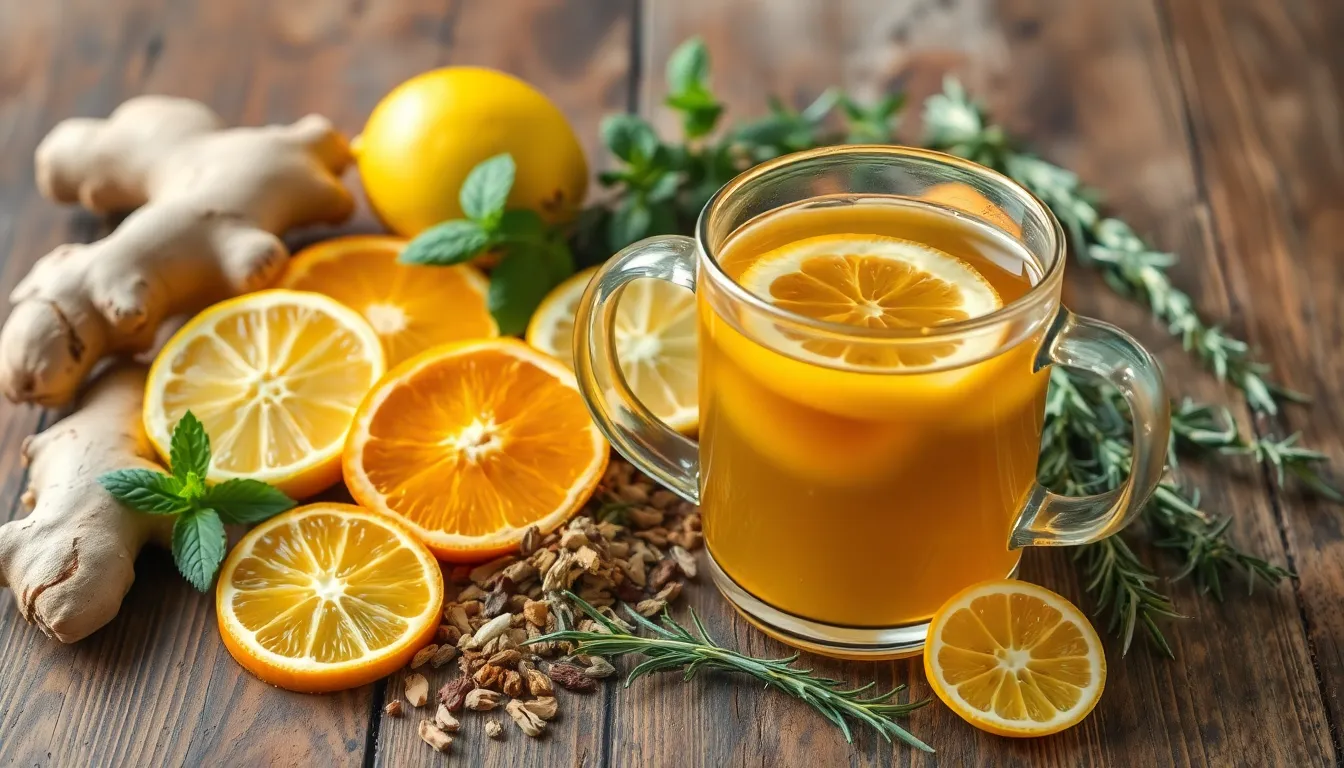
When we need natural energy without caffeine jitters, energizing herbal teas provide the perfect solution. These invigorating blends combine potent herbs that boost circulation, enhance mental clarity, and support sustained vitality throughout our day.
Ginger Citrus Tea
Ingredients:
- 1 tablespoon fresh ginger, grated or sliced
- 1 teaspoon lemon or orange zest
- 1 cup water
- Honey to taste (optional)
Instructions:
We start by bringing one cup of water to a rolling boil in our kettle. Add the grated ginger and citrus zest to our brewing vessel. Pour the boiling water over the herbs and allow the mixture to steep for 10 minutes. Strain the tea through a fine mesh strainer to remove all herb particles. Sweeten with honey if desired.
Ginger improves circulation and reduces inflammation throughout our body, contributing to increased energy levels. Citrus fruits like lemon and orange provide rich vitamin C content, which helps combat fatigue and boosts our natural alertness.
Peppermint Rosemary Tea
Ingredients:
- 1 tablespoon dried peppermint leaves
- 1 teaspoon fresh rosemary sprigs or dried rosemary
- 1 cup water
- Natural sweetener (optional)
Instructions:
We begin by heating water to boiling temperature. Combine peppermint leaves and rosemary in our tea infuser or directly in the cup. Pour the hot water over our herb mixture and steep for 10 minutes to extract maximum beneficial compounds. Remove the herbs by straining, then add sweetener according to taste preferences.
Peppermint aids digestion while providing mental clarity for a refreshing energy boost. Rosemary enhances memory and concentration, creating a complementary effect with peppermint’s invigorating properties that supports both cognitive and physical energy.
Yerba Mate Blend
Ingredients:
- 1 tablespoon yerba mate
- 2-3 fresh ginger slices
- 4-5 fresh peppermint leaves
- 1 cup water
- Sugar or honey (optional)
Instructions:
We peel and slice the fresh ginger into thin rounds. Combine yerba mate, ginger slices, and peppermint leaves in our tea strainer or infuser. Place the loaded strainer in a mug and pour boiling water over the herb blend. Allow steeping for 8-10 minutes for optimal extraction. Remove the strainer and add sweetener if we prefer a sweeter taste.
Yerba mate contains natural caffeine and antioxidants that provide sustained energy without the crash associated with coffee. Combined with ginger and peppermint, this blend improves both our physical stamina and cognitive energy while supporting digestive health and mental focus.
Digestive Herbal Tea Recipes

We’ve crafted these herbal tea blends specifically to support your digestive system and provide relief from common stomach discomforts. These therapeutic recipes combine traditional botanicals known for their ability to soothe digestive issues and promote optimal gut health.
Fennel Ginger Tea
This warming blend combines the carminative properties of fennel seeds with the anti-inflammatory benefits of fresh ginger to create a powerful digestive remedy. Fennel seeds work by relaxing intestinal muscles and reducing gas, bloating, and stomach cramps, while ginger adds its renowned ability to alleviate nausea and improve overall digestion.
Ingredients:
- 1 teaspoon crushed fennel seeds
- 1-inch piece fresh ginger, thinly sliced
- 2 cups boiling water
- Honey to taste (optional)
Instructions:
- Crush fennel seeds lightly using the back of a spoon to release their essential oils
- Place crushed fennel seeds and fresh ginger slices in your teapot or large mug
- Pour boiling water over the herbs and cover immediately
- Steep for 8-10 minutes to extract maximum digestive compounds
- Strain the tea and add honey if desired
- Drink warm 20-30 minutes after meals for optimal digestive support
Dandelion Root Tea
Dandelion root tea offers a mildly bitter flavor that stimulates digestive secretions and supports liver function to kickstart your digestive process. This therapeutic brew promotes bile flow, acts as a gentle laxative, and helps alleviate bloating and constipation while supporting natural detoxification pathways.
Ingredients:
- 2 teaspoons dried dandelion root
- 2 cups boiling water
- Lemon slice (optional)
Instructions:
- Measure dried dandelion root into your tea infuser or directly into teapot
- Pour boiling water over the dandelion root
- Cover and steep for 10-15 minutes to extract the beneficial compounds
- Strain thoroughly to remove all plant matter
- Add a lemon slice to enhance flavor and vitamin C content
- Drink 1-2 cups daily before meals to stimulate digestive function
Licorice Root Blend
Our licorice root blend creates a naturally sweet and soothing tea that coats and heals the gastrointestinal lining. Licorice root contains compounds that reduce inflammation in the digestive tract, protect against ulcers, and improve gut barrier function while supporting adrenal health.
Ingredients:
- 1 teaspoon dried licorice root
- 1/2 teaspoon dried chamomile flowers
- 1/2 teaspoon dried peppermint leaves
- 2 cups boiling water
- Combine licorice root, chamomile, and peppermint in your tea infuser
- Pour boiling water over the herbal blend
- Cover and steep for 12-15 minutes to create a rich, healing brew
- Strain the tea to remove all herb particles
- The natural sweetness of licorice root eliminates the need for added sweeteners
- Drink warm between meals to soothe digestive inflammation and support gut healing
Immune-Boosting Herbal Tea Recipes
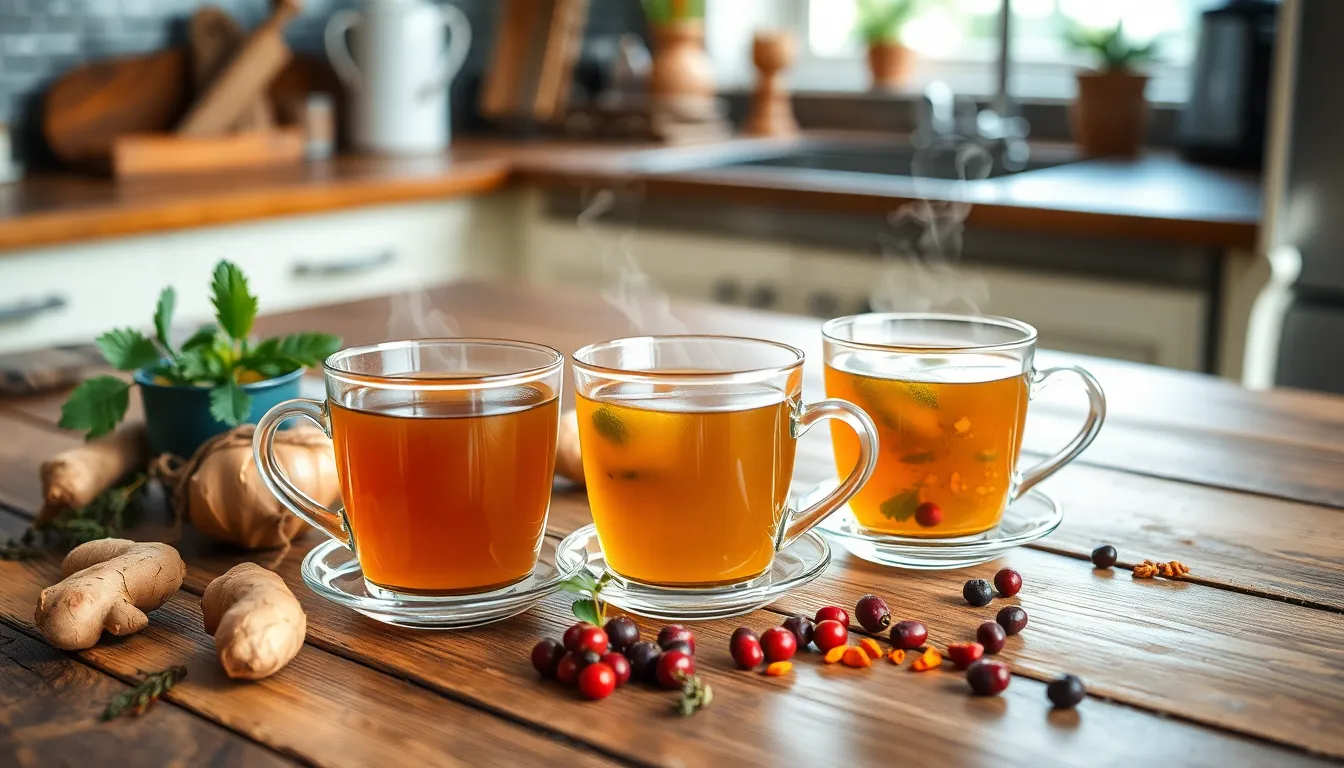
Building upon our foundation of digestive wellness teas, we now explore powerful herbal blends specifically designed to strengthen immune function. These recipes combine traditional botanicals with proven antimicrobial and antiviral properties to create effective immunity support beverages.
Echinacea Elder Tea
This traditional immune-supporting blend harnesses the power of two renowned botanical allies. Echinacea stimulates immune function while elderberries provide rich antioxidants and antiviral properties that help prevent and alleviate cold and flu symptoms.
Ingredients:
- 1 tablespoon dried echinacea root or leaves
- 1 tablespoon dried elderberries
- 1 teaspoon fresh lemon juice
- 1 teaspoon raw honey
- 2 cups boiling water
Add echinacea and elderberries to a teapot or large mug. Pour boiling water over the herbs and steep for 10 minutes. Strain the mixture and stir in lemon juice and honey while the tea remains warm. This combination creates a potent immune defense that tastes pleasantly tart and floral.
Turmeric Ginger Tea
Fresh turmeric and ginger create our most powerful anti-inflammatory immune blend. Both roots contain active compounds that provide antiviral and antioxidant benefits while supporting respiratory health during seasonal challenges.
Ingredients:
- 1 inch fresh ginger root, diced
- 1 inch fresh turmeric root, diced (or 1 teaspoon ground turmeric)
- 1 fresh lemon, juiced
- 1 fresh orange, juiced
- 1 cinnamon stick or 1/2 teaspoon ground cinnamon
- 2 teaspoons raw honey or maple syrup
- 2 cups boiling water
Place ginger, turmeric, and cinnamon in a teapot. Pour boiling water over the ingredients and steep for 5 minutes. Strain the tea and add lemon juice, orange juice, and honey. Stir well before serving. The citrus adds vitamin C while honey soothes the throat and contributes additional antioxidants.
Rose Hip Hibiscus Tea
Rose hips and hibiscus flowers deliver exceptional vitamin C content in this tangy immune-boosting blend. These botanicals offer antiviral and antimicrobial effects while their high antioxidant levels support immune health and reduce inflammation.
Ingredients:
- 2 tablespoons dried rose hips
- 1 tablespoon dried hibiscus flowers
- 1 teaspoon dried orange peel
- 1 teaspoon raw honey (optional)
- 2 cups boiling water
Combine rose hips, hibiscus flowers, and orange peel in a teapot. Pour boiling water over the mixture and allow to steep for 8 minutes for optimal vitamin extraction. Strain thoroughly and sweeten with honey if desired. This ruby-red tea provides a tart, cranberry-like flavor while delivering powerful immune support through concentrated vitamin C and antioxidants.
Seasonal Herbal Tea Recipes
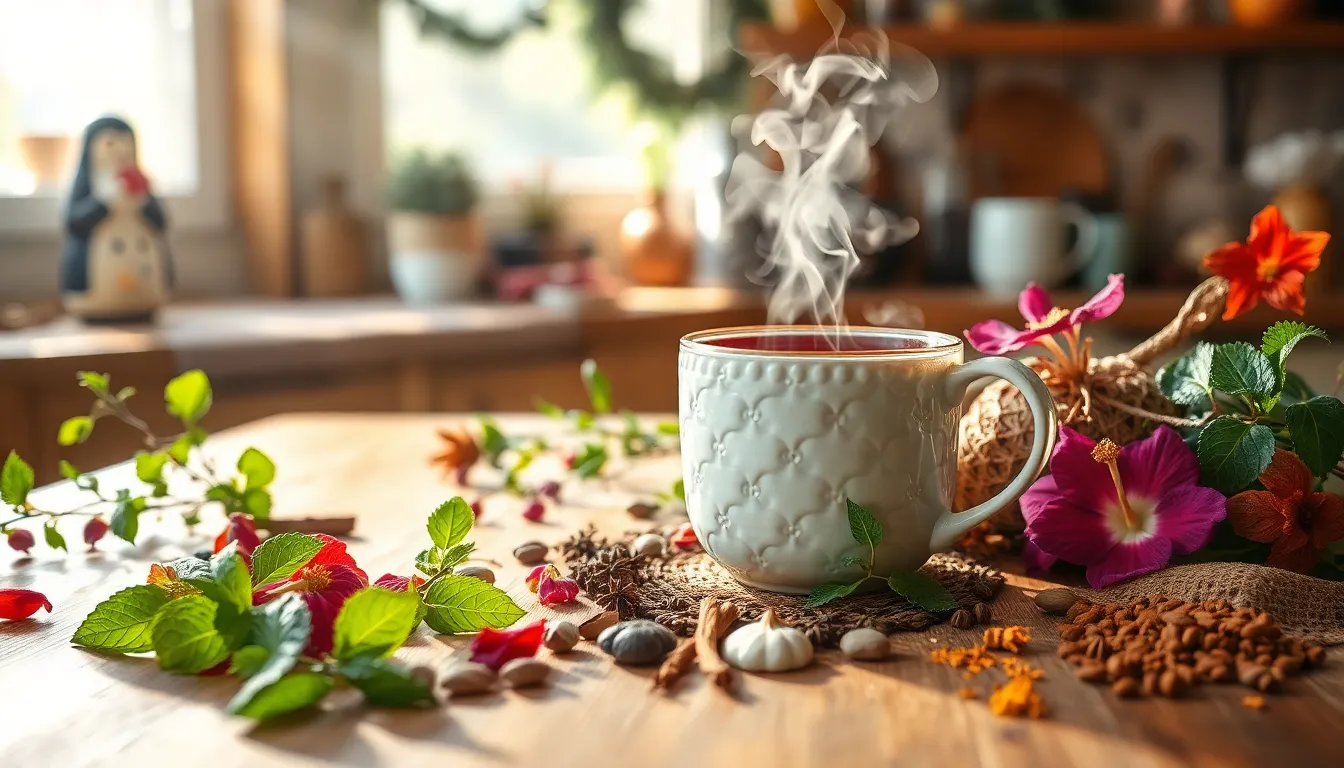
We celebrate the changing seasons by crafting herbal tea blends that reflect nature’s rhythm and address our body’s evolving wellness needs. Each season brings unique botanical treasures that support our health while delivering flavors perfectly suited to the time of year.
Spring Detox Tea
Spring awakens our bodies with the need for gentle cleansing and renewal after winter’s dormancy. We combine fresh mint leaves with dried nettle or dandelion leaf to create a powerful detoxification blend that supports metabolism and digestion.
Ingredients:
- 2 tablespoons fresh mint leaves
- 1 tablespoon dried nettle or dandelion leaf
- 1 lemon slice
- 1 cup hot water
Instructions:
- Combine mint leaves and dried nettle or dandelion leaf in your tea infuser or teapot
- Add the lemon slice to enhance vitamin C content and provide refreshing zest
- Pour hot water over the herb mixture
- Steep for 5 to 10 minutes to extract maximum beneficial compounds
- Strain the tea and enjoy while warm
Mint provides cooling properties that support digestive health while nettle delivers essential minerals for energy renewal. Dandelion leaf acts as a gentle liver cleanser that promotes natural detoxification processes.
Summer Cooling Tea
Summer heat calls for hydrating blends that cool the body and provide gentle diuretic effects. We feature hibiscus and peppermint as our primary cooling agents with the addition of fresh cucumber and lemon balm for maximum refreshment.
Ingredients:
- 1 to 2 tablespoons fresh peppermint or lemon balm
- 1 tablespoon dried hibiscus flowers
- 2 to 3 cucumber slices
- 1 cup hot water
Instructions:
- Bruise or lightly crush the fresh herbs to release their essential oils
- Place crushed herbs and hibiscus flowers in your tea infuser
- Add cucumber slices for extra cooling properties
- Pour hot water over the mixture
- Steep for 5 to 8 minutes
- Strain and serve hot or pour over ice for iced tea
Hibiscus delivers vibrant color and powerful antioxidants while peppermint and lemon balm provide immediate cooling relief. The cucumber adds hydrating minerals that support summer wellness needs.
Fall Spice Tea
Fall brings the desire for warming spices that support immune function and prepare our bodies for cooler weather. We blend traditional warming spices with seasonal fruit elements to create a comforting and health-supportive beverage.
Ingredients:
- 1 teaspoon ground cinnamon
- 1/2 teaspoon fresh grated ginger
- 1/4 teaspoon ground cloves
- 1/4 teaspoon ground turmeric
- 1 piece dried apple or orange peel
- 1 cup hot water
Instructions:
- Combine all spices in a small bowl to create your spice blend
- Add 1 tablespoon of the spice mixture to your tea infuser or teapot
- Include the dried apple or orange peel for seasonal sweetness
- Pour hot water over the spice blend
- Cover and steep for 5 to 10 minutes to develop full flavor
- Strain and serve immediately
Cinnamon and ginger support healthy circulation while cloves provide antimicrobial properties. Turmeric offers anti-inflammatory benefits and the dried fruit adds natural sweetness with seasonal appeal.
Winter Warming Tea
Winter demands deeply warming blends that provide comfort and immune support during the coldest months. We create a base of caffeine-free rooibos enhanced with traditional warming spices and vitamin C-rich rose hips.
Ingredients:
- 2 tablespoons rooibos tea
- 1 tablespoon dried rose hips
- 1 cinnamon stick (chopped)
- 1/4 teaspoon ground cardamom
- 2 to 3 whole cloves
- 1 cup hot water
Instructions:
- Measure rooibos and rose hips as your tea base
- Add chopped cinnamon stick and whole cloves to the mixture
- Sprinkle cardamom over the blend
- Use 1 heaping tablespoon of the complete mixture per 8 ounces of water
- Steep for 3 to 5 minutes to prevent over-extraction
- Strain and enjoy while hot
Rooibos provides minerals and antioxidants without caffeine while rose hips deliver immune-supporting vitamin C. The warming spices create internal heat that combats winter’s chill and supports respiratory health.
Tips for Growing Your Own Herbs
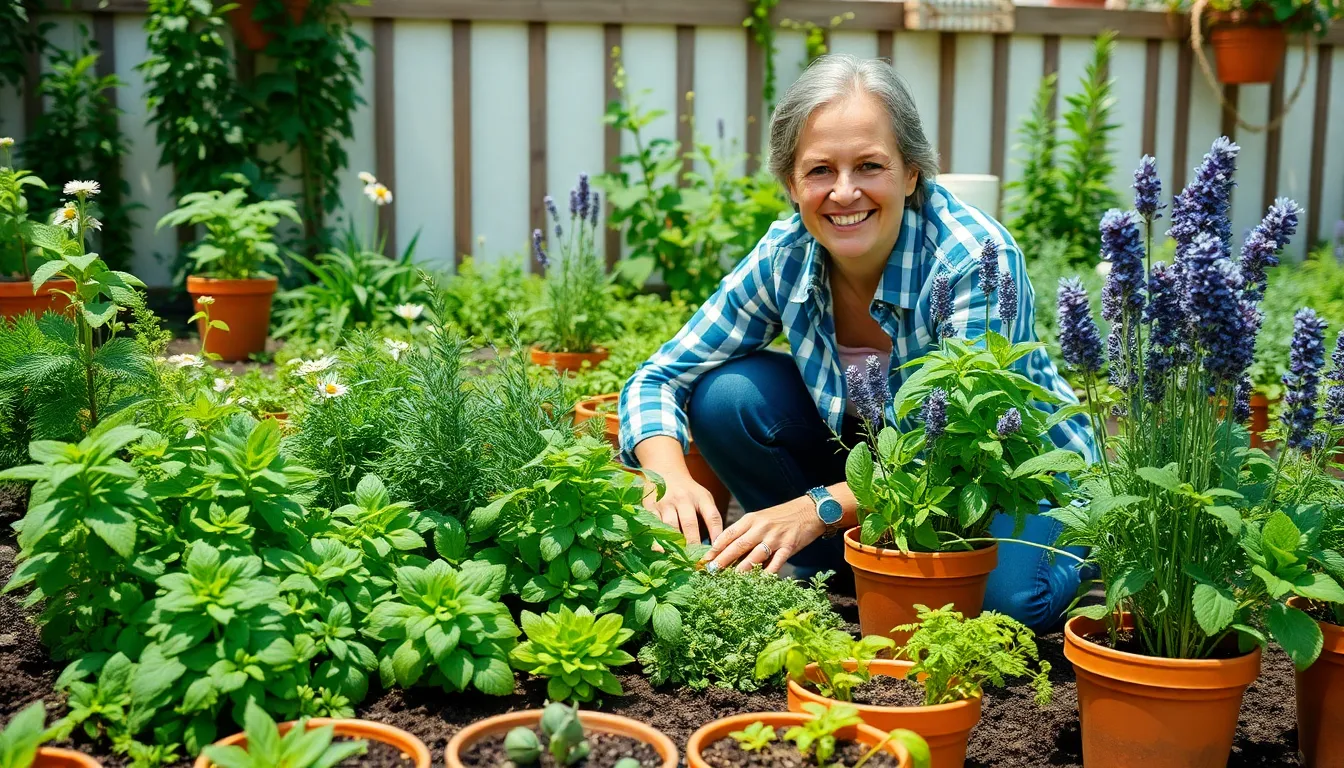
Growing our own herbs for tea creation transforms our relationship with these healing plants while ensuring we always have fresh ingredients at our fingertips. We recommend starting with these foundational steps to establish a thriving herbal tea garden.
Select a Sunny Location becomes our first priority when planning our herb garden. Most herbs require at least 6 hours of sunlight per day to develop their essential oils and therapeutic compounds fully. We should identify the sunniest spots in our garden or choose south-facing windows for container growing.
Use Well-Draining Soil prevents root rot and other moisture-related problems that can destroy our herbal plants. Herbs prefer soil that does not retain excess water since most originated in Mediterranean climates with dry conditions. We can improve drainage by adding compost or sand to heavy clay soils.
Water Regularly maintains healthy growth without overwhelming our plants with excessive moisture. We keep soil moist but not soggy by checking the top inch of soil before watering. Morning watering sessions work best since they allow plants to dry before evening temperatures drop.
Harvest Often encourages continuous growth and prevents our herbs from becoming woody or bitter. We prune herbs regularly to stimulate new leaf production and maintain plant vigor. Regular harvesting also prevents flowering in many herbs which can reduce leaf quality for tea making.
Choose Easy-to-Grow Varieties ensures success for beginners while providing excellent tea ingredients. Mint, chamomile, lemon balm, and lavender are beginner-friendly options that require minimal care yet produce abundant harvests. These varieties adapt well to various growing conditions and provide the foundation ingredients for our most popular tea blends.
Container growing offers flexibility for those with limited space or challenging soil conditions. We can move containers to optimize sunlight exposure and protect tender herbs during extreme weather. Terra cotta pots work exceptionally well since they provide excellent drainage while allowing roots to breathe.
Companion planting maximizes our garden space while creating beneficial relationships between different herbs. We plant tall herbs like rosemary behind shorter varieties such as thyme to create natural windbreaks. Strong-scented herbs like mint should be contained since they spread aggressively and can overtake other plants.
Seasonal planning extends our harvest throughout the year and provides ingredients for our seasonal tea blends. We succession plant quick-growing herbs like cilantro and dill every few weeks for continuous harvests. Cold-hardy varieties like rosemary and sage provide fresh ingredients even during winter months in many climates.
Storing and Preserving Herbal Teas
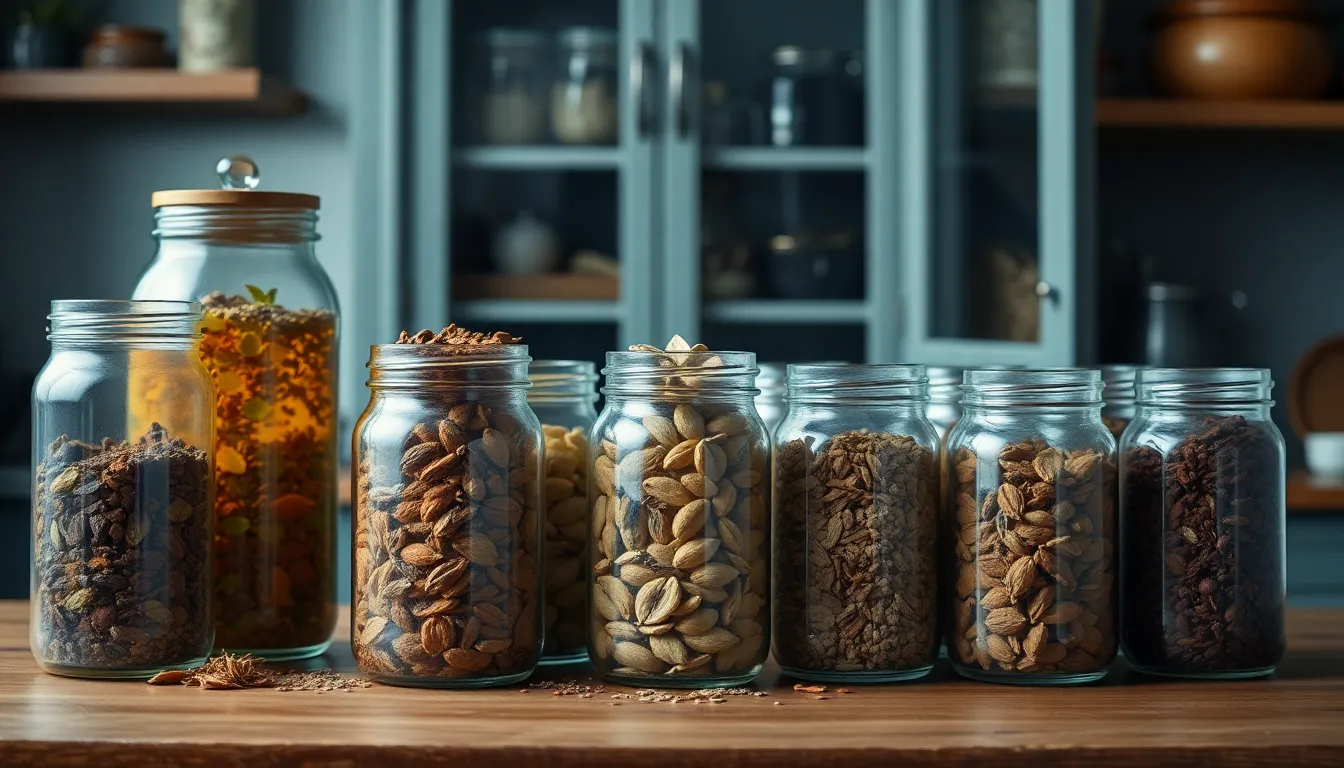
Proper storage makes the difference between herbal teas that maintain their vibrant flavors and those that lose their therapeutic potency. We must protect our carefully crafted herbal blends from the elements that can rob them of their essential oils and beneficial compounds.
Choose the Right Storage Containers
Glass jars offer the best protection for our herbal tea collections. These containers create an airtight seal that prevents moisture and air from degrading our precious botanicals. Ceramic canisters work equally well and add an elegant touch to our tea storage system. Mylar bags provide excellent barrier protection against light and air when we need portable storage options.
Plastic containers should never house our herbal teas. These materials absorb odors from surrounding environments and can leach chemicals that alter both flavor and safety profiles of our carefully selected herbs.
Create Optimal Storage Conditions
Cool and dark locations preserve the integrity of our herbal teas far better than warm or bright spaces. We recommend storing containers away from heat sources like stoves and ovens that can accelerate the breakdown of volatile compounds. Direct sunlight destroys the delicate essential oils that give our herbal blends their distinctive characteristics and wellness benefits.
Kitchen cabinets positioned away from appliances create ideal storage environments. Pantries and dedicated tea storage areas maintain the consistent temperatures our herbal teas need to stay fresh.
Monitor Shelf Life and Quality
| Storage Method | Shelf Life | Quality Indicators |
|---|---|---|
| Airtight containers | Up to 1 year | Fresh aroma and color |
| Improper storage | 3-6 months | Faded color and weak scent |
| Signs of spoilage | Immediate disposal | Mold, off odors, color changes |
Regular inspection of our stored herbal teas helps us catch quality issues before they affect our brewing experience. Herbs with dried fruits or flowers require more frequent checking since these ingredients attract moisture and spoil more quickly than leaves alone.
Prevent Flavor Transfer and Contamination
Strongly scented herbs like peppermint and eucalyptus need separate storage containers to prevent their bold flavors from overwhelming more delicate blends. We store each herbal variety in its own airtight container to maintain the unique character we worked to create in our blends.
Airtight storage also prevents pest infestations that can destroy entire collections of herbal teas. Moths and other insects cannot penetrate properly sealed containers, protecting our investment in quality herbs.
Temperature and Humidity Considerations
Water at 160–200°F (70–93°C) provides optimal extraction during brewing, but storage temperatures should remain consistently cool. High humidity environments accelerate degradation, so we avoid storing herbal teas in areas prone to moisture like bathrooms or near dishwashers.
Steeping times of 4–7 minutes work best with properly stored herbs that retain their full potency. Degraded herbs often require longer steeping times and produce weaker flavors even with extended brewing periods.
Following these storage guidelines ensures our homemade herbal tea blends deliver the same satisfying flavors and wellness benefits months after we first prepared them. Fresh, properly stored herbs reward us with consistent brewing results and maintain the therapeutic properties we seek in our daily tea rituals.
Make-Ahead Instructions
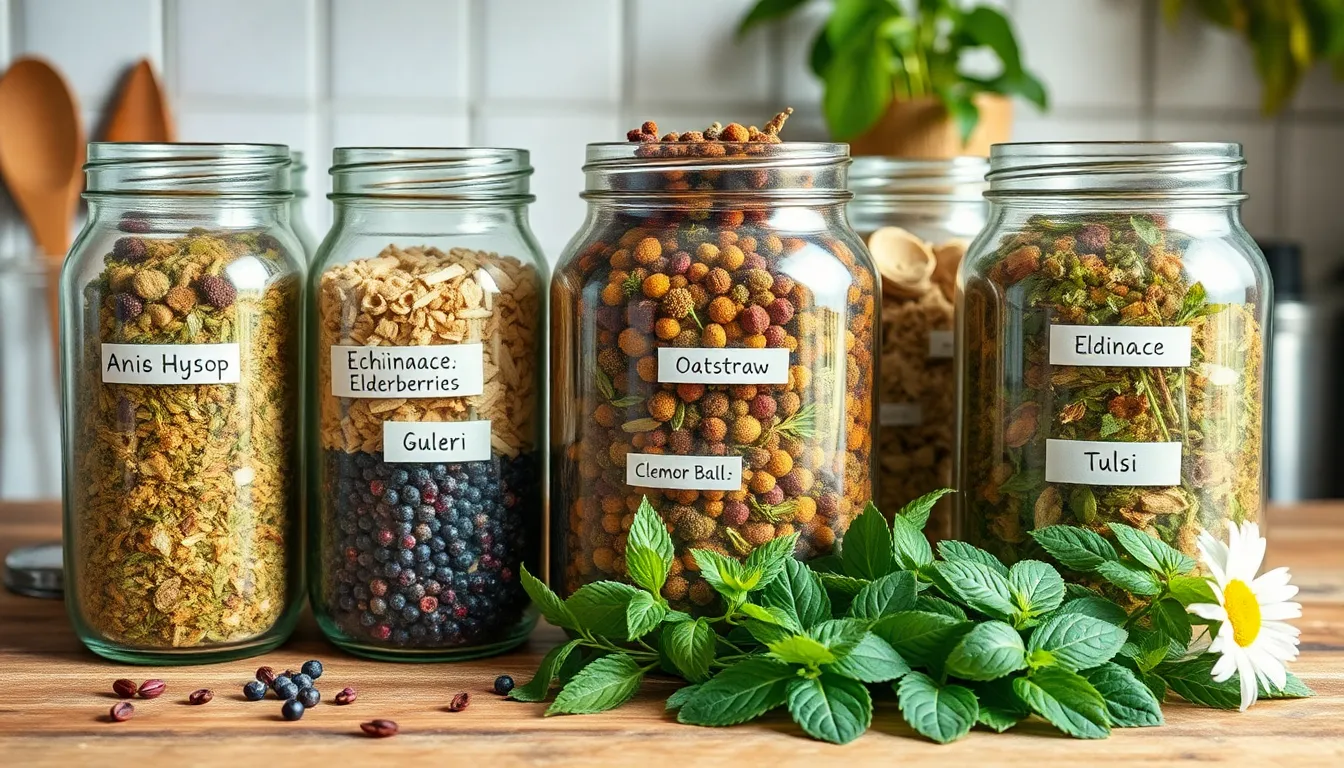
Creating herbal tea blends ahead of time transforms your tea routine into an effortless daily ritual. We can prepare these therapeutic combinations in advance to ensure our favorite wellness blends are always ready when we need them most.
Preparing Tea Blends in Advance
We recommend mixing dried herbs and storing them in airtight containers to streamline our tea preparation process. This approach allows us to easily scoop out the desired amount whenever we want to brew a comforting cup.
| Blend Type | Storage Method | Shelf Life |
|---|---|---|
| Dried herb blends | Airtight containers | Up to 6 months |
| Fresh herb combinations | Immediate use preferred | 2-3 days maximum |
Mix and Store: We combine the dried herbs in a large bowl first, ensuring even distribution of all ingredients throughout the blend. After thorough mixing, we transfer the complete blend to clean, airtight glass jars or ceramic canisters.
Label and Store: We label each container with the exact ingredients and brewing instructions for future reference. These prepared blends store best in cool, dark places away from direct sunlight and heat sources.
Our Winter Warming Tea Blend exemplifies this make-ahead approach perfectly. We combine 2 tablespoons each of anise hyssop, echinacea, elderberries, oatstraw, and tulsi with 1 tablespoon of damiana. This creates enough blend for multiple servings, with each tablespoon providing the perfect amount for 8 ounces of water.
Storing Fresh Herb Combinations
Fresh herbs require immediate attention for optimal flavor and therapeutic benefits. We prioritize using fresh herbal combinations within hours of preparation to capture their peak potency and vibrant essence.
When immediate use isn’t possible, we wrap fresh herb combinations in slightly damp cloth or paper towels. This method maintains moisture levels while preventing the herbs from becoming soggy or wilted. We then store these wrapped bundles in the refrigerator for a maximum of 2 to 3 days.
Cool Storage Method: We place fresh herb combinations in the coolest part of our refrigerator, typically the crisper drawer. This environment provides optimal humidity levels while protecting delicate leaves and flowers from temperature fluctuations.
Quality Assessment: We inspect stored fresh herbs daily for signs of wilting, browning, or loss of aromatic intensity. Any herbs showing these deterioration signs should be used immediately or composted to prevent spoilage from affecting other stored herbs.
For our Calming Herbal Tea blend containing lemon balm, passionflower, skullcap, chamomile, and spearmint, we prepare only what we plan to use within the day when working with fresh ingredients. But, the dried version of this blend stores beautifully for months when properly contained.
Conclusion
We’ve explored the wonderful industry of herbal tea recipes and discovered how simple ingredients can transform into powerful wellness elixirs. From growing your own herbs to mastering storage techniques these natural remedies offer endless possibilities for supporting our health goals.
The journey from dried botanicals to soothing cups of herbal goodness doesn’t require expensive equipment or complex procedures. With basic kitchen tools and quality ingredients we can create personalized blends that address our exact wellness needs throughout every season.
Whether you’re seeking better sleep digestive support or immune enhancement there’s an herbal tea recipe waiting to become part of your daily ritual. Start experimenting with these natural combinations and experience firsthand how these time-tested botanical treasures can enhance your overall well-being.
Frequently Asked Questions
What are herbal teas and how are they different from regular tea?
Herbal teas, also called tisanes, are caffeine-free beverages made by infusing dried or fresh herbs, flowers, fruits, and spices in hot water. Unlike traditional teas made from the Camellia sinensis plant, herbal teas use various botanical ingredients that offer unique therapeutic properties and flavors without containing caffeine.
What health benefits do herbal teas provide?
Herbal teas offer numerous health benefits including antioxidant protection, anti-inflammatory support, improved cardiovascular health, better digestion, enhanced sleep quality, and immune system strengthening. Specific herbs like hibiscus can lower blood pressure, chamomile promotes relaxation, and ginger supports digestive health through their bioactive compounds.
What equipment do I need to make herbal tea at home?
You need minimal equipment to make herbal tea: a kettle for heating water, a mug or teapot for brewing, and an infuser or fine mesh strainer to contain loose herbs. Optional accessories include tea scoops and tongs. Most required tools are already found in typical kitchens.
How do I properly brew herbal tea for best results?
Use boiling water at 212°F (100°C) for most herbal teas. Steep for 5-10 minutes depending on the herbs used. Use approximately 1 teaspoon of dried herbs per cup of water, or 5 grams for 16 ounces of water. Longer steeping times extract more beneficial compounds and stronger flavors.
Can I grow my own herbs for making tea?
Yes, growing your own herbs is rewarding and ensures fresh ingredients. Choose a sunny location with well-draining soil and water regularly. Easy-to-grow varieties for beginners include mint, chamomile, and lavender. Container growing works well for limited spaces, and regular harvesting promotes continued growth throughout the season.
How should I store homemade herbal tea blends?
Store herbal teas in airtight glass jars or ceramic canisters in cool, dark locations away from heat and sunlight. Avoid plastic containers that can absorb odors. Properly stored dried herb blends maintain quality for up to six months, while fresh herb combinations should be used within 2-3 days.
Can I make herbal tea blends in advance?
Yes, you can prepare make-ahead herbal tea blends by mixing dried herbs and storing them in airtight containers. These pre-made blends last up to six months when properly stored. Label containers with ingredients and preparation dates for easy identification and optimal freshness tracking.
Which herbal teas are best for relaxation and sleep?
Chamomile, lavender, lemon balm, and passionflower are excellent for promoting relaxation and better sleep. Chamomile Lavender Tea and Lemon Balm Mint Tea are particularly effective calming blends that help reduce stress and prepare your body for restful sleep through their natural sedative properties.
Are there herbal teas that can boost energy without caffeine?
Yes, several herbal teas provide natural energy without caffeine jitters. Ginger, peppermint, rosemary, and yerba mate (which contains some caffeine) create energizing blends. Ginger Citrus Tea and Peppermint Rosemary Tea offer refreshing energy boosts through their stimulating aromatic compounds and metabolism-supporting properties.
What herbal teas help with digestion?
Fennel, ginger, dandelion root, and licorice root are excellent for digestive support. These herbs help relieve stomach discomfort, reduce bloating, and promote healthy digestion. Fennel Ginger Tea and Dandelion Root Tea are particularly effective for addressing common digestive issues and supporting overall gut health.

